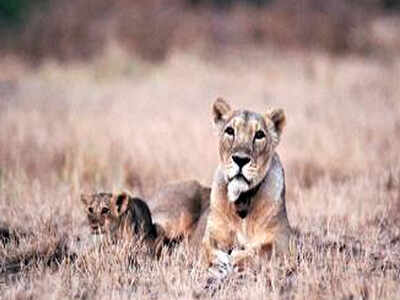
AHMEDABAD: Legendary lioness Rajmata, aged 20 years and the longest surviving subspecie in Asia, breathed her last on Saturday. Her last rites were held on Sunday at Vadal Animal Care Centre near Palitana. Apart from her age, what surprised the animal kingdom were her pregnancies. She also holds the record among Asiatic lions for having given birth to 15 cubs in seven litters.
In fact, the existing population in Amreli's Liliya Kakrach of 50-60 lions, lionesses and cubs is believed to be her progeny.
“The maximum life span of Asiatic lions is usually about 16 years. Rajmata was an exception. She lived for 20 years and had seven litters,” said Y V Jhala, senior researcher with Wildlife Institute of India. He had radio collared the lioness in 2008 for research in Greater Gir.
Nisha Raj, district forest official (DFO) Shetrunjay Wildlife Division, confirmed the death of Rajmata and said she was cremated as per protocol. She died of old age, said Raj.
Jalpan Rupapara and Purvesh Kacha, two doctors who have closely studied Rajmata along with other lion population in Greater Gir region, said her last offspring was in 2018. Rajmata started failing in her health after her youngest progeny went missing in the very same year. The cub is believed to have fallen prey to cannibalism.
“Barring her first litter, we have witnessed rest six litters during our study. In her first, second and third pregnancy, she had given birth to three cubs in each litter,” according to Rupapara. In the fourth and fifth pregnancy, she had given birth to two cubs each, said Kacha.
In the last two pregnancies, Rajmata gave birth to one cub each but both did not survive long as they fell prey to cannibalism.
According to Rupapara, she was the pioneer lioness in setting up her kingdom in Liliya Kakrach area. It was in 2008, she was captured from Shetrunjay division after her second delivery and was later released in Hadala range in Gir East where she was radiocollared.
She was about six years then and was named as ‘collar wali sinhan’ (collared lioness). In 2016, she was given the name of Rajmata by the locals due to her firm hold on her kingdom. Rajmata did not allow any other lioness to encroach her territory.
Rajmata was sharp enough to avoid being captured
Rajmata later lost track of her home range and reached Gondal. It took the forest department seven days to capture her and her three cubs.
The forest officials set up ringed cages to capture them, however Rajmata avoided the trap. “From her earlier experience of being caged, she had become alert. She was so sharp that she kept wandering for 15-20 kilometers a day to avoid being captured again. The forest officials had to tranquilize her on the seventh day to take her to Shakkarbaug zoo,” said Rupapara.When locals came to know that Rajmata was held in captivity in Shakkarbaug zoo, they began a movement to get her released. Letters were written to senior forest officials for setting her free, said Rupapara. Finally, she was released after six months of being caged at Sakkarbaug zoo. From then on 2008, there was no turning back for Rajmata. She ruled the Liliya-Kakrach area since then.
In fact, the existing population in Amreli's Liliya Kakrach of 50-60 lions, lionesses and cubs is believed to be her progeny.
“The maximum life span of Asiatic lions is usually about 16 years. Rajmata was an exception. She lived for 20 years and had seven litters,” said Y V Jhala, senior researcher with Wildlife Institute of India. He had radio collared the lioness in 2008 for research in Greater Gir.
Nisha Raj, district forest official (DFO) Shetrunjay Wildlife Division, confirmed the death of Rajmata and said she was cremated as per protocol. She died of old age, said Raj.
Jalpan Rupapara and Purvesh Kacha, two doctors who have closely studied Rajmata along with other lion population in Greater Gir region, said her last offspring was in 2018. Rajmata started failing in her health after her youngest progeny went missing in the very same year. The cub is believed to have fallen prey to cannibalism.
“Barring her first litter, we have witnessed rest six litters during our study. In her first, second and third pregnancy, she had given birth to three cubs in each litter,” according to Rupapara. In the fourth and fifth pregnancy, she had given birth to two cubs each, said Kacha.
In the last two pregnancies, Rajmata gave birth to one cub each but both did not survive long as they fell prey to cannibalism.
According to Rupapara, she was the pioneer lioness in setting up her kingdom in Liliya Kakrach area. It was in 2008, she was captured from Shetrunjay division after her second delivery and was later released in Hadala range in Gir East where she was radiocollared.
She was about six years then and was named as ‘collar wali sinhan’ (collared lioness). In 2016, she was given the name of Rajmata by the locals due to her firm hold on her kingdom. Rajmata did not allow any other lioness to encroach her territory.
Rajmata was sharp enough to avoid being captured
Rajmata later lost track of her home range and reached Gondal. It took the forest department seven days to capture her and her three cubs.
The forest officials set up ringed cages to capture them, however Rajmata avoided the trap. “From her earlier experience of being caged, she had become alert. She was so sharp that she kept wandering for 15-20 kilometers a day to avoid being captured again. The forest officials had to tranquilize her on the seventh day to take her to Shakkarbaug zoo,” said Rupapara.When locals came to know that Rajmata was held in captivity in Shakkarbaug zoo, they began a movement to get her released. Letters were written to senior forest officials for setting her free, said Rupapara. Finally, she was released after six months of being caged at Sakkarbaug zoo. From then on 2008, there was no turning back for Rajmata. She ruled the Liliya-Kakrach area since then.
Quick Links
Kerala Coronavirus Helpline NumberHaryana Coronavirus Helpline NumberUP Coronavirus Helpline NumberBareilly NewsBhopal NewsCoronavirus in DelhiCoronavirus in HyderabadCoronavirus in IndiaCoronavirus symptomsCoronavirusRajasthan Coronavirus Helpline NumberAditya ThackerayShiv SenaFire in MumbaiAP Coronavirus Helpline NumberArvind KejriwalJammu Kashmir Coronavirus Helpline NumberSrinagar encounter
Get the app










